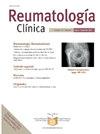Association between hypothyroidism and elderly-onset rheumatoid arthritis: A cross-sectional study at national hospital in Peru
IF 1.3
Q4 RHEUMATOLOGY
引用次数: 0
Abstract
Objective
To determine the association between hypothyroidism and elderly-onset rheumatoid arthritis (EORA).
Methods
A cross-sectional study was performed including patients with rheumatoid arthritis at the Adolfo Guevara Velasco National Hospital, Cusco, Peru in 2024. The outcome was EORA, defined as disease onset after 60 years old. The exposure was a history of hypothyroidism, and the following covariates were considered: sex, smoking, family history of autoimmune disease in first-degree relatives, rheumatoid factor and anti-CCP levels. The association between hypothyroidism and EORA was assessed using prevalence ratios (PR) with their 95% confidence interval (CI), estimated by generalized linear models with a Poisson family, log link, and robust variance. A p-value <0.05 was considered statistically significant.
Results
A total of 133 patients were included, 14 (10.5%) of whom had EORA. The mean age was 55 ± 12.6 years and 90% were female. Only 8.3% of patients reported a history of hypothyroidism. Hypothyroidism was significantly associated with EORA (adjusted PR 9.03, 95% CI 3.17–26.68). Other factors associated with EORA were disease duration, smoking, the history of autoimmune disease in a first-degree relative, and rheumatoid factor.
Conclusions
A history of hypothyroidism was independently associated with EORA in patients with rheumatoid arthritis from Peru. Screening for hypothyroidism in EORA patients may enhance management and address autoimmune comorbidities.
甲状腺功能减退与老年类风湿关节炎之间的关系:秘鲁国家医院的横断面研究
目的探讨甲状腺功能减退与老年类风湿关节炎(EORA)的关系。方法对2024年在秘鲁库斯科阿道夫·格瓦拉·贝拉斯科国立医院就诊的类风湿性关节炎患者进行横断面研究。结果为EORA,定义为60岁以后发病。暴露为甲状腺功能减退史,考虑了以下协变量:性别、吸烟、一级亲属自身免疫性疾病家族史、类风湿因子和抗ccp水平。甲状腺功能减退和EORA之间的关系通过患病率(PR)及其95%置信区间(CI)进行评估,并通过泊松家族、对数关联和稳健方差的广义线性模型进行估计。p值<;0.05被认为具有统计学意义。结果共纳入133例患者,其中EORA患者14例(10.5%)。平均年龄55±12.6岁,女性占90%。仅有8.3%的患者报告有甲状腺功能减退病史。甲状腺功能减退与EORA显著相关(调整后的PR为9.03,95% CI为3.17-26.68)。与EORA相关的其他因素有病程、吸烟、一级亲属自身免疫性疾病史和类风湿因子。结论秘鲁类风湿关节炎患者甲状腺功能减退史与EORA独立相关。筛查EORA患者的甲状腺功能减退可以加强管理和解决自身免疫性合并症。
本文章由计算机程序翻译,如有差异,请以英文原文为准。
求助全文
约1分钟内获得全文
求助全文
来源期刊

Reumatologia Clinica
RHEUMATOLOGY-
CiteScore
2.40
自引率
6.70%
发文量
105
审稿时长
54 days
期刊介绍:
Una gran revista para cubrir eficazmente las necesidades de conocimientos en una patología de etiología, expresividad clínica y tratamiento tan amplios. Además es La Publicación Oficial de la Sociedad Española de Reumatología y del Colegio Mexicano de Reumatología y está incluida en los más prestigiosos índices de referencia en medicina.
 求助内容:
求助内容: 应助结果提醒方式:
应助结果提醒方式:


